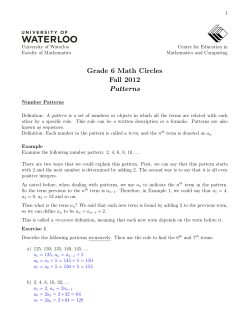
Fibonacci Sequence
Fibonacci Sequence The Fibonacci Sequence is the series of numbers written about by an Italian mathematician Leonardo Fibonacci: 0, 1, 1, 2, 3, 5, 8, 13, 21, 34, ... The next number is found by adding up the two numbers before it. The 2 is found by adding the two numbers before it (1+1) Similarly, the 3 is found by adding the two numbers before it (1+2), And the 5 is (2+3), and so on… When you make squares with this number they create a spiral: Fibonacci numbers can be found just about anywhere in nature. In particular, they show up often in plants that have multiple parts (such as leaves, petals or seeds). Five leaved flower found in woods at Arisaig Park Five is the fifth number in the Fiboncci sequence. These trees start with one trunk for the first two years. The following year, they branch off into 3 and then the year after that, 5 branches. Fibonacci goes 1,1,2,3,5,….. A Pine tree grows three to five new branches every month. The branches on this pine tree are part of the Fibonacci sequence and this is why; five is the fifth Fibonacci number and three is the fourth Fibonacci number. This plant’s leaves represent Fibonacci numbers because it has 5 leaves. We found a buttercup at Arisaig Park. A buttercup has five pedals. Five is the fifth number in the Fibonacci sequence. This is a Strawberry plant. It follows the Fibonacci pattern by having 3 leaves. This is a strawberry flower. It fits the Fibonacci pattern by having five leaves. These maple leaves have five main veins in them. Some maple leaves have five points per leaf, others have four. This is a sheep sorrel. It fits the Fibonacci pattern by having three leaves. Written by the Grade 4 Class, 2012 Grace Wilson, Noel Fougere, Jay MacDonald, Iain Polson, Ethan MacDougall, Jenna Gavin, Bailey Williams, Rachel MacQuarrie, Alex Van de Sande, Emily Ketchum, Callum Fraser, Riley Mattie, Stephen Carmichael, Jillian Delaney & Mrs. Tiffany MacNeil
© Copyright 2025





















